
March 1
| 1936 |
The Hoover Dam was completed in 1936. Heavily travelled U.S. 93 ran along the dam's crest until October 2010, when the Hoover Dam Bypass opened. |
| 1966 |
In the Providence Journal's auditorium in Rhode Island, BPR Assistant Regional Engineer Robert Kellum conducts a hearing on standards for the Highway Beautification Act of 1965. Pro-billboard speakers contend the proposed standards go far beyond the act's intent. Anti-billboard speakers say "trapped motorists" deserve stretches of highway free of advertisements. Governor John Chafee endorses the standards and promises to comply speedily when they are finalized. |
| 1988 |
The 2-year, $210-million reconstruction of the Dan Ryan Expressway in Chicago, IL, between 31st Street and the Eisenhower Expressway, gets underway. Because of careful planning of alternate routes and an extensive publicity campaign, the closing of two northbound lanes today (and subsequent lane closings) do not result in the widely expected traffic nightmare. A March 2 article in the Chicago Sun-Times about the closing is headlined, "A Breeze!" and begins, "Rush hour? What rush hour?" (See December 5, 1970.) 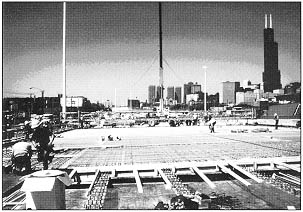
|
March 2
| 1925 |
In response to a resolution adopted by AASHO during its annual meeting in 1924, Secretary of Agriculture Howard M. Gore appoints the Joint Board on Interstate Highways to study how to designate the Nation's main interstate roads. Chief Thomas MacDonald chairs the committee, with BPR's E. W. James as secretary and A. B. Fletcher as a member. The Joint Board, which includes representatives of 21 State highway agencies, creates the U.S. numbered highway system. (AASHO continues to designate U.S. route numbers today.) |
| 1974 |
Administrator Norbert Tiemann announces an agreement with the National Council of State Garden Clubs, Inc., and the State highway agencies for "Operation Wildflower" to promote the planting and growth of wildflowers along Federal-aid highways. |
March 3
| 1893 |
In one of President Benjamin Harrison's last acts before leaving office, he signs the Agriculture Appropriations Act of 1894, appropriating $10,000 for a road inquiry that gets underway with formation of the ORI, headed by General Roy Stone, on October 3, 1893. An associate of General Stone wrote to him in New York to tell him why Stone's broader bill had not been considered: Senate supporters of both bills "decided that it was more discreet to save the appr'n of $10nd, as it stood, than to attract attention to it by an amendment, & run the risk of a debate & losing all-hence the inaction." " . . . to make inquiries in regard to the systems of road management throughout the United States . . . to make investigations in regard to the best method of road-making . . . and to enable [the Secretary of Agriculture] to assist the agricultural college and experiment stations in disseminating information on this subject . . . " |
| 1936 |
In a referendum, Vermont's voters defeat a proposition to buy right-of-way for the Green Mountain Parkway, effectively killing the proposal. The parkway, which would have run the length of the State, had been proposed by the NPS, BPR, and the Vermont Bureau of Public Works. Reporting the results of the referendum, the Rutland Herald said, "Now in truth Vermont can say not only that she is, but that she will remain unspoiled-unspoiled in character, in common sense, in dignity, as well as in scenery." |
| 2009 |
President Barack Obama visits DOT along with Vice President Joe Biden to discuss the American Recovery and Reinvestment Act of 2009, which is intended to help the country recover from a deep recession. In the East Atrium, the President says, "we will be investing $28 billion in our highways, money that every one of our 50 States can start using immediately to put people back to work." (See April 13, 2009) |
March 4
| 1894 |
General Roy Stone transmits ORI Bulletin No. 4 to Secretary of Agriculture J. Sterling Morton for release: Road Making Materials in Arkansas by State Geologist John C. Branner. The introduction begins: "The quagmires, ruts, and wrecked wagons that mark our common highways, the reckless waste of the old road system, and the social and commercial isolation that such roads impose upon our people-and especially upon our farmers-during a large part of the winter and spring months must sooner or later convince us that bad roads cost more than good ones." |
| 1911 |
A. L. Westgard (known as "The Pathfinder") of the Touring Club of America begins the first transcontinental trip by truck (a 37- horsepower truck called the "Pioneer Freighter"). Director Logan Page has appointed Westgard an OPR Special Agent (unpaid). 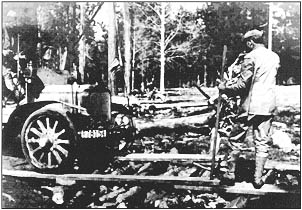
|
| 1915 |
The FY 1916 appropriations act for the Agriculture Department combines the Divisions of Drainage and Irrigation (Office of Experiment Stations) and the farm architecture work of the Office of Farm Management Investigations with OPR, which is renamed the Office of Public Roads and Rural Engineering. The change is effective July 1, 1915. |
March 5
| 1918 |
OPRRE assigns an engineer to help the U.S. Shipping Board Housing Corporation in working out highway and street problems in connection with housing projects during World War I. A similar arrangement was made with the U.S. Housing Corporation of the Department of Labor. |
| 1990 |
Administrator Thomas Larson is in Turkey to celebrate the 40th anniversary of the Directorate of Turkish Highways, which BPR helped establish. With his Turkish counterpart, Atalay Coskunoglu, Dr. Larson signs a technical cooperation agreement. 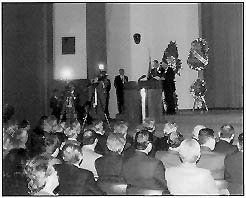
|
| 1995 |
Phyllis Etheridge Young reports for her new assignment as Division Administrator in Jackson, Mississippi. She is the first African-American woman appointed an FHWA Division Administrator. Thirty years earlier, she had joined BPR (effective date: July 4, 1965) as the first African-American woman to be a mathematical statistician in the Office of Research. |
March 6
| 1913 |
Director Logan Page presides as the Second National Good Roads Federal-Aid Convention opens at the Raleigh Hotel in Washington. Following a reception by President Woodrow Wilson at the White House, the first speech of the afternoon is by M. de Pulligny, France's Chief Engineer of Roads and Bridges, who outlines the road building methods of that country. |
| 1934 |
President Franklin Roosevelt transmits a report to Congress on the reconnaissance survey for the proposed Inter-American Highway from Panama to the United States (requested in the Inter-American Highway Act, March 4, 1929). A BPR engineering party had established an office in Panama on July 1, 1930, and completed field work by May 1933. |
| 1943 |
Based on a field survey in February, Senior Highway Engineer H. A. Stoddart of PRA completes a report on disabled U.S. Army and contractor equipment along the Whitehorse Division of the Alaska Highway, resulting from the haste of construction and the difficulty of securing repair parts. |
March 7
| 1954 |
Mrs. Mildred W. Helvestine, Chief, Library Branch, and 13 members of her staff receive sustained superior performance awards totalling $1,850, one of the largest group awards ever made by BPR. The 14 recipients have a cumulative 221 of service to BPR. The News in Public Roads says that, "The international reputation of the Public Roads Library stems at least as much from the capable and courteous service provided by the staff as it does from the unparalleled collections in the Library." |
| 1975 |
In a White House ceremony conducted by President Gerald Ford, William T. Coleman, Jr., becomes the first African-American to serve as Secretary of Transportation. The oath of office is administered by Coleman's friend and colleague, Supreme Court Justice Thurgood Marshall. President Ford tells the guests that the new Secretary has a mandate to help save energy, develop mass transportation, strengthen the railroads, and ensure an equitable and stern enforcement of the 55 m.p.h. speed limit brought on by oil shortages. For FHWA, his tenure would be marked by direct involvement in settling highway controversies. 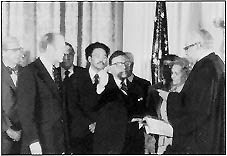
|
March 8
| 1973 |
The 1.7-mile, $112-million Eisenhower Memorial Tunnel on I-70 in Colorado, bypassing Loveland Pass, opens after a brief ceremony conducted about 500 feet inside the tunnel's entrance west of Denver. The ceremony is moved inside because the weather includes a temperature of 34 degrees and snow flurries. Governor John Love says, "This tunnel, as part of the interstate system, represents the most recent, and possibly the most effective, answer to tying east and west Colorado together and opening the way west." (On July 17, 1973, the one-millionth vehicle passed through the tunnel.) |
| 1990 |
In the Old Executive Office Building, President George Bush and Secretary of Transportation Samuel Skinner unveil the National Transportation Policy (NTP), developed by a USDOT team under Deputy Secretary Elaine Chao and Administrator Thomas Larson after an extensive public/private sector outreach. The policy will, in the Secretary's words, "set a course that will ensure we have a transportation system that supports our national goals for the future." The USDOT's legislative proposals for the post-Interstate era-unveiled in this same room on February 13, 1991-are based on the NTP and lead directly to ISTEA. "An investment in transportation is an investment in America's future." |
March 9
| 1965 |
President Lyndon Johnson signs the $1.1 billion Appalachian Regional Development Act, creating the Appalachian Regional Commission and authorizing construction of the Appalachian Development Highway System and local access roads. |
| 1974 |
The Governing Board of the National Research Council approves a replacement for the Highway Research Board: the Transportation Research Board. |
| 1992 |
A 3-day U.S./Mexico Roundtable on Concessionary Transportation Infrastructure gets underway in Manzanillo, Mexico, to encourage cooperative enterprise. Administrator Thomas Larson heads a U.S. delegation of nearly 100 public and private sector officials. "The converging economies of Mexico and the United States are both highway dependent for efficient and reliable transportation . . . . Given the job at hand, neither of us can afford to waste resources. We need to find new and innovative public and private partnerships." |
March 10
| 1919 |
The Indiana State Highway Commission becomes the last State highway agency to qualify for funding under the 1916 Federal Aid Road Act. The original commission had suspended operations when the 1917 legislation establishing it was challenged as unconstitutional. After the Indiana Supreme Court ruled in the State's favor, the General Assembly passed an act, effective this date, creating the commission. |
| 1953 |
At the Stevens Institute of Technology in Hoboken, NJ, Wilbur H. Simonson, Chief of BPR's Roadside Branch, delivers the First Lecture in the Horace Brown Lecture Series sponsored by the New Jersey Roadside Council. In "Evolution of the Parkway to the Complete Highway," he says that studying earlier examples "will give you a clearer vision of complete highway design as a way of life-the American way, bright with the promise of opportunity to serve your fellow man in the years to come." "The complete highway is the product of the combination of good engineering design and good landscape design applied in balanced agreement." |
March 11
| 1906 |
During an official meeting of the City Council of Demopolis, AL, today and tomorrow, OPR advice results in a unanimous sentiment to advance the standard of road improvement. The city asks for construction of an object lesson road. |
| 1993 |
Transportation Planner Wilfred Owen addresses FHWA's Research and Technology Coordinating Committee. He advises that research into demand-side solutions to sustaining mobility could allow the transportation sector to lead in addressing national needs, such as making cities more livable, reducing unnecessary commuter traffic, implementing land conservation, protecting the environment, and saving energy. |
March 12
| 1907 |
In an address to ARMA's Fourth Annual Convention, in Pittsburgh, PA, Director Logan Page summarizes the history of the good roads movement and explains OPR's mission: "We hope to succeed in partially mitigating the deplorable conditions due to incorrect methods of road construction; to induce some of the road builders to exercise judgment in the selection of their road materials; to enable legislators, by placing proper information before them, to improve existing legislation." "We can never hope entirely to drive out incorrect methods, wasteful extravagance, unsuitable laws, and inadequate organization until every State is organized; and the spirit of cooperation is the main factor in all our endeavors." |
| 1919 |
Chief Thomas MacDonald issues regulations implementing the FY 1920 Post Office Appropriation Act of February 28, 1919. In implementing the new law, the regulations incorporate changes in response to suggestions by State highway officials, during AASHO's Annual Meeting last December, for resolving disagreements or delays identified under the Federal-aid highway program. |
| 1968 |
Public Roads Director Frank Turner issues an Instructional Memorandum on "Bridge Safety Inspection," which includes the first guide on evaluating bridge conditions. Stanley Gordon of the Bridge Division had developed the guide at Turner's request following the collapse of the Silver Bridge (see December 15, 1967). Gordon has been called "the Father of Bridge Inspection." 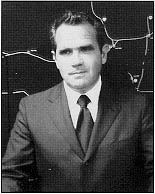
Bridge Division |
| 1970 |
FHWA Regional Safety Specialists Stanley Keesling and Sam Luebbert, while attending the annual meeting of the Mississippi Valley Institute of Traffic Engineers in Oklahoma City, OK, tell a reporter about tests of self-inflating balloons that are being tested as a new way of protecting motor vehicle occupants in collisions. Luebbert says, "I would love to have students-who are always looking for causes-get traffic safety as a cause." |
March 13
| 1915 |
In Washington, DC, Governor James B. McCreary of Kentucky and State Commissioner of Public Roads R. C. Terrell meet with Secretary of Agriculture D. F. Houston and OPR, receiving all available information on the best methods of developing good roads. The Governor tells a reporter, "I think I am safe in saying there is no other State in the union where good roads enthusiasm is at higher tide than in Kentucky." 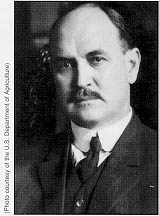
Secretary of Agriculture |
| 1918 |
Work is completed on a road from Quantico Marine Corps base in Virginia to the Richmond-Washington highway, with BPR's C. L. Brown advising the post quartermaster. |
| 1967 |
BPR Public Information Officer Robert S. Marx, speaking before the Regional Landscape Architects on "Improving the Bureau's Public Image," begins by saying that promoting the highway beautification program sometimes makes him feel "not unlike the man who pushed his mother-in-law over the cliff in his brand new Cadillac." |
March 14
| 1903 |
A State law is enacted authorizing the use of convicts to build a public road from Santa Fe to Las Vegas, NM. At the State's request, OPRI Special Agent James W. Abbott inspected the road and advised the State of his findings in 1904. OPRI's annual report states that the mountain road is "destined to become famous because of scenic attraction and excellence of construction." 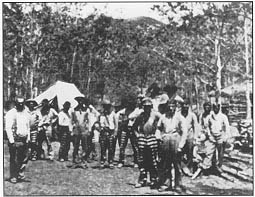
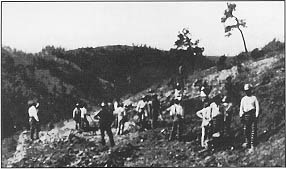 |
| 1913 |
OPR's George D. Marshall addresses a good roads meeting in Hamilton, TX, on "Good Roads Yesterday, To-day and Forever." According to Southern Good Roads magazine, Marshall "is not only a good engineer but he is a very fine speaker." |
| 1942 |
President Franklin Roosevelt sends letters to the Governors of the 48 States asking each one to establish and enforce a 40-m.p.h. speed limit as a wartime measure to conserve tires and the Nation's rubber supply. The request is based in part on data provided by PRA to the Office of Defense Transportation on numbers of motor vehicles, gasoline consumption, and highway use. |
| 1978 |
FHWA issues a "Policy Statement on the Minimization of Red Tape," which calls for review of all reporting requirements; State, local, and public involvement in the development of regulations and directives; and strengthened communication with local governments. |
March 15
| 1922 |
Chief Thomas MacDonald is elected one of the four initial directors of the Eno Foundation, established by William Phelps Eno in 1921 to perpetuate his work in promoting safety and discipline on streets and highways. |
| 1961 |
A medium-scale computer with four magnetic tape units and 8,000 characters of memory is installed in BPR's Washington Headquarters, replacing a medium-size digital computer, compatible with punch cards, installed in July 1958. 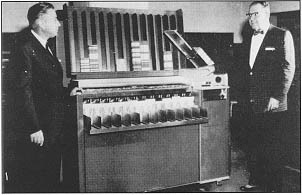
|
| 1990 |
Administrator Thomas Larson is in Turkey to celebrate the 40th anniversary of the Directorate of Turkish Highways, which BPR helped establish. |
March 17
| 1914 |
OPR joins with the American Highway Association (see November 22, 1910) in an object lesson in road maintenance, cooperating with the States and 49 counties to maintain the 893-mile Washington-to-Atlanta Highway. In OPR's FY 1914 annual report, Director Logan Page says the goal is to demonstrate "road maintenance on a sufficient scale to attract general attention, and at the same time render the largest amount of assistance at the least relative cost to the Office of Public Roads." The demonstration, supervised by OPR's Division of Maintenance, continues until 1917. |
March 18
| 1976 |
Based on a request from the National Advisory Committee on Uniform Traffic Control Devices, FHWA adopts new design standards for signs identifying tourist information centers, welcome centers, and rest areas. |
| 1985 |
The First North American Pavement Management Conference opens at the Royal York Hotel in Toronto, Canada. Cosponsored by FHWA and the Ontario Ministry of Transportation and Communications (in cooperation with AASHTO, TRB, and the Roads and Transportation Association of Canada), the conference is chaired by Dr. R. K. (Ramesh) Kher of the Ontario Ministry. Among those addressing the conference are Deputy Administrator Lester Lamm ("Major Pavement Investment Management Issues and Prospects for the U.S. Federal Highway Network") and Administrator Thomas Larson ("Improved Pavement Maintenance: Accelerating the Search for Innovation"). |
March 19
| 1903 |
OPRI's Western Agent, James W. Abbott, addresses the Texas good roads convention, explaining the technical features of highway construction. M. O. Eldridge delivers his popular illustrated lecture on "The Highways of the World." 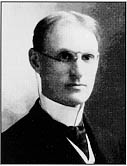
Assistant Director Office of Public Road Inquiry |
| 1969 |
Secretary of Transportation John Volpe administers the oath of office to Administrator Francis C. Turner. Guests include Senator Jennings Randolph, Chairman of the Committee on Public Works; Representative George H. Fallon, Chairman of the Committee on Public Works; and Representative John C. Kluczynski, a member of the committee. |
March 20
| 1914 |
OPR Superintendent of Road Construction D. H. Winslow addresses the New Hampshire Road Convention on "Special Problems in the New England States." He begins, "It has been said that 'you can always tell a New Englander, but you cannot tell him much' . . . . He is 'willing to be convinced, but would like to see the man that can convince him.'" |
| 1943 |
PRA contractors complete the south river pier for the Peace River Bridge on the Alaska Highway. PRA's Raymond Archibald is in charge of design and construction. (The bridge collapsed on October 16, 1957, following a landslide. A replacement structure opened in January 1960). |
March 21
| 1929 |
BPR's E. W. James sails to Bogota as a member of a commission formed to prepare a plan for improving transportation and communications in Colombia. |
| 1980 |
In accordance with Executive Order 12185, dated December 17, 1979, FHWA issues FHWA Notice N 5520.4 establishing "policy and broad direction on energy for the Federal-aid highway program and to identify areas that possess the greatest potential for fuel conservation." |
| 1985 |
To handle a large post-deregulation truck safety workload imposed by new legislation, the BMCS is superseded by an upgraded Office of Motor Carriers, with Richard Landis brought in from the Arizona Highway Patrol as the first Associate Administrator for Motor Carriers. He takes office September 15, 1985. 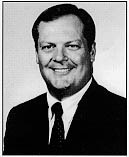
Associate Administrator for Motor Carriers |
March 22
| 1918 |
The contract is awarded for Ohio's Federal-Aid Project #1, involving a 13.63-mile stretch of the National Pike in Muskingum County. Construction begins May 1 and the project is completed in October, with Governor James M. Cox laying the last brick. |
| 1968 |
FHWA's National Highway Safety Bureau conducts a 1-day seminar on vehicle safety standards at the Pick-Congress Hotel in Chicago, IL. The meeting, held primarily for organizations representing recreational vehicles, truck trailers, and truck body and equipment industries, covers the Motor Vehicle Safety Act of 1966 and Federal vehicle safety standards. |
| 1994 |
Following an inspirational battle with cancer, FHWA Transportation Engineer James F. Condron dies today. On April 22, as a memorial to his contribution to the Agency, the Georgia Division Office renames its Merit Award in his honor. The Condron Award will be given annually to a Georgia DOT employee for outstanding performance of his or her job during the year. 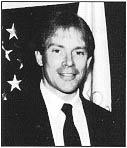
Transportation Manager Georgia Division Office |
March 23
| 1903 |
OPRI's M. O Eldridge addresses a good roads meeting at Ft. Smith, AR. "Some counties are wasting their [highway bond] money because the work is done in a crude manner and not under the direction of expects." He also stresses the importance of maintenance: "A little mud hole may be fixed before it gets big and does a great deal of damage. Any man who knows his business may with the toe of his boot turn off a little stream of water, which will do $100 worth of damage if left alone." |
| 1964 |
President Lyndon Johnson sends a message to Secretary of Commerce Luther Hodges calling for an accelerated safety program known as the safety spot improvement program to encourage States to use FAP and FAS funds to eliminate or reduce hazards. |
| 1967 |
Lowell K. Bridwell is sworn in as Federal Highway Administrator by Secretary of Transportation Alan Boyd and takes office. On January 20, 1964, Bridwell had taken office as Acting Deputy Administrator, replacing the first Deputy Administrator, D. Grant Mickle, and was appointed Deputy Under Secretary of Commerce for Transportation (Operations) on July 2, 1964. |
| 1999 |
The Conexpo-Con/Agg exposition opens in Las Vegas. During the exposition, Nevada Division Administrator John Price accepts an award honoring FHWA for the Interstate System, selected as one of the Top 10 Construction Projects of the 20th century. |
March 24
| 1908 |
Director Logan Page sends a letter to officials of 49 railroad companies seeking their help in OPR's study of county and township road management. "I shall be greatly obliged if you will assist us by giving the names of such counties along the line of your road as appear to have the best systems and are obtaining the best results in the improvement of their roads without undue expense." He took this action, and called on other sources, after concluding that obtaining complete, accurate, and unbiased reports from the counties themselves would be impossible. |
| 1960 |
BPR Commissioner Ellis Armstrong begins a 3-day series of hearings on the controversial issue of where to route I-64 between Louisville, KY, and St. Louis, MO. When a photographer's flash bulb explodes at the start of the third day, Armstrong comments, "I didn't expect the shooting to start so quickly." |
March 25
| 1942 |
In preparation for construction of the Alaska Highway, PRA officials and guides leave Fort Nelson, British Columbia, on a dog team reconnaissance trip to Watson Lake. Another team leaves the Hudson's Bay Trading Post on the Sikanni Chief River on a reconnaissance trip to Fort Nelson. According to Highway Engineer W. H. Curwen, "Rations carried on this trip . . . consisted of the following: sausages, bacon, flour, sugar, salt, canned butter, tea, dry milk, dried eggs, baking powder, dried fruits, dehydrated vegetables, supplemented with 21 grouse, and about 10 pounds of moose meat obtained from trappers." Rations for the dogs consisted of cornmeal cooked with tallow. 
|
| 1974 |
As authorized by the 1973 Federal-Aid Highway Act, FHWA issues guidelines authorizing, for the first time, the use of Federal-aid highway funds for construction of bikeways and pedestrian walkways outside the highway right-of-way along Federal-aid highways. |
| 1992 |
The $8 million Travtek project, an experimental IVHS project financed by FHWA, AAA, General Motors, the Florida DOT, and the city of Orlando, gets underway. The goal is to provide traffic congestion information, motorist services information ("yellow pages"), tourist information, and route guidance to operators of 100 test vehicles equipped with in-vehicle TravTek devices. |
March 26
| 1993 |
The 2-day Conference for State DOT Bicycle/Pedestrian Coordinators concludes in San Diego, CA. The conference, coordinated by FHWA Bicycle Program Manager John Fegan, gives the participants, representing 45 States, the opportunity to meet each other, share information about their activities, and learn what resources are available at the national level. Most participants were appointed after ISTEA required each State to have a coordinator. |
March 27
| 1893 |
In a decision on Monongahela Navigation Company v. United States, Supreme Court Justice David Brewer states that, "the power of Congress to regulate commerce carries with it power over all the means and instrumentalities by which commerce is carried on . . . . We are so much accustomed to see artificial highways, such as common roads, turnpike roads and railroads, constructed under the authority of the States, and the improvement of natural highways [waterways] carried on by the general government, that at the first it might seem that there was some inherent difference in the power of the national government over them. But the grant of power is the same." |
| 1964 |
An earthquake damages roads and bridges in Alaska. BPR's Region 10 moves into action to help the Alaska Department of Highways restore service. On April 17, BPR concurs in Governor William A. Egan's emergency proclamation and allocates an initial $4.2 million in emergency relief funds. |
| 1969 |
1969 Secretary of Transportation John Volpe announces a new post, Special Assistant to the Administrator, to ensure enforcement of Equal Employment Opportunity requirements. Alexander D. Gaither, currently Chief of FHWA's Equal Employment Opportunity Division, fills the position. In an order dated March 17, Volpe requires that equal practices be made part of every Federal-aid highway project contract or subcontract of $10,000 or more. 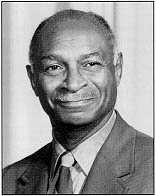
Special Assistant to the Administrator for Equal Employment Opportunity |
March 28
| 1946 |
Nebraska becomes the first State to accept its tentatively integrated Interstate System, a map of which PRA had transmitted to the State highway agencies on March 14 for their concurrence. By the end of the fiscal year, PRA had received acceptances from 37 States and the District of Columbia. Seven States had not replied officially and four had proposed alternate routes that did not meet the routes proposed by adjoining States. (See August 2, 1947.) |
March 29
| 1920 |
In a letter to General Inspector L. I. Hewes in Portland, OR, Chief Thomas MacDonald discusses BPR's responsibilities. Given the 50-50 matching shares, he says, "we have equal responsibility with the States for securing adequate returns to the public. [In fact,] I feel that we should take at least 50 percent of the responsibility . . . because we will get the full one hundred per cent of responsibility for failures." MacDonald also recommends that "our district engineers should work with the State highway departments toward the completion of a program which will include the roads in their order of importance, and in so far as possible place the projects in the order which will complete the main State systems before side roads are undertaken." "Our organization as a whole must be absolutely honest and fair. It should be competent. It should be broad and above personalities in its dealings with the public generally and with individuals." |
March 30
| 1956 |
BPR issues PPM 20-7 on "Archeological and Paleontological Salvage." It is superseded on October 19 by a revised PPM implementing Section 120 of the Federal-Aid Highway Act of 1956, under which Federal-aid highway funds may be used by State highway departments for archeological and paleontological salvage in compliance with An Act for the Preservation of American Antiquities (June 8, 1906) or State laws. The October 19 PPM states, "When a road location or improvement is in an area where it is anticipated that historical objects may be encountered, the appropriate authority should be advised as early as possible of the exact location of the road to enable such authority to determine the likelihood of the highway destroying historical objects." |
March 31
| 1953 |
"The Chief," Thomas H. MacDonald, retires after heading BPR for 34 years (1919-1953). He had stayed beyond the mandatory retirement age of 70 with approval of the President. During testimony in April before the House Roads Subcommittee, Secretary of Commerce Sinclair Weeks says, "There is nothing intended or implied, so far as I know . . . that in any way, shape or manner tends toward any watering down, so to speak, of the Bureau of Public Roads." During the hearings, Undersecretary Robert Murray, Jr., denies rumors that BPR is going to be dissolved. 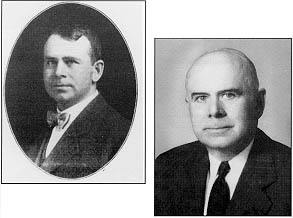
"The Chief" from 1919 to 1953 |
| 1976 |
At 4 p.m., Transportation Secretary William Coleman, Jr., and Administrator Norbert Tiemann open the "Highways of History" exhibit in the lobby of the Old Pension Building in Washington, DC. The exhibit features 109 paintings by BPR's Carl Rakeman, pronounced Rock-a-mon. (See October 17, 1979.) |
Also in March
| 1905 |
OPR's 1-year civil engineering training program, begun in the fall of 1904 for college graduates, is given formal status. First year salary: $600. Arthur E. Loder is the first civil-engineer student to receive special instruction in road building. |
| 1919 |
American Motorist, AAA's magazine, quotes Thomas Edison: "I think the Federal Government should emulate France and establish a national college where men would be specially taught road and bridge building only." "I have traveled over four thousand miles of French roads, main and lateral, built by the central government and also kept in perfect repair, and I note with pain and humiliation the horrible mess that is made by us in our road building, arising from dense ignorance and otherwise." |
| 1960 |
After BPR orders, at the Defense Department's request, a 16-foot vertical clearance for all overhead structures on the Interstate System, Michigan becomes the first State to raise an expressway overpass. The 500-ton beams, carrying Clear Lake Road over I-94 east of Jackson, were the first span of a partially completed deck. |
| 1963 |
Twenty-five highway and associated engineers participate in a 3-week course on the application of nuclear energy to the highway program. The Oak Ridge Institute of Nuclear Studies, Inc., sponsored by the Atomic Energy Commission, collaborated with BPR in conducting the course, which was initiated by Percy L. Blackwell, Chief, Nuclear Energy Branch. |
| 1970 |
The National Highway Safety Bureau separates from FHWA to become NHTSA. |
